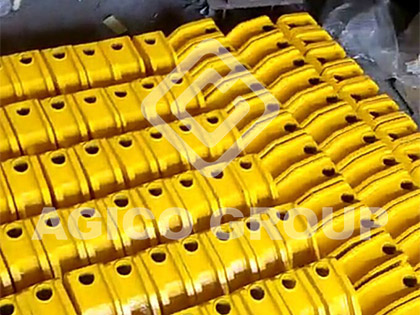Introduction of railway sleeper types from agico

Railroad tie, also known as railway sleeper,is mainly used under steel rails with proper gauge. The weight of steel rail is loaded to rail sleepers when train passes, and then distributed to the ballast.
As it is seen from the railway lines, rail sleepers are laid horizontally underneath tracks, it is the main part in holding rail lines in place at the correct gauge.Each year, millions of rail sleepers made of different materials are manufactured and applicated in railway line construction and maintenance.
How does railway sleepers work
Railway sleepers has 4 main functions: fix steel rails to maintain uniform gauge; pass the weight force of steel rails to ballast evenly to maintain horizonal level; reduce vibration when train is passing steel rails; hold steel rails in position in longitudinal direction.
Classification of Railway Sleepers
Based on the materials used, railway sleepers are classified into following types.

- Wooden sleepers
- Concrete sleepers
- Steel sleepers
- Cast iron sleepers
- Composite sleepers
Wooden Sleepers
Wood sleepers are railway sleepers made of wood, it has a long history of application and still can be seen in many places, especially western countries. The common raw materials are oak, jarrah, teakwood, etc.
| Wooden Sleeper Overview | |
|---|---|
| Benefits | Disadvantages |
| Wood sleepers are cheaper than others and easy to manufacture. | Life of wooden sleepers is very less compared to others. |
|
They are light in weight so, they can be easily transported and handled while installing |
Weak against fire. |
|
Fasteners can be easily installed to wooden sleepers |
Easily affected by humidity which will cause dry rot, wet rot etc. |
| They are good insulators so, rails are well protected. | Vermin attack can be possible if it is not properly treated. |
| Any type of gauge can be maintained by wooden sleepers. | Poor creep resistance. |
| They are suitable for all types of rail section. | Good Attention is required even after laying. |
| They are well suitable for tracks in coastal areas. | |
Concrete Sleeper
Concrete sleeper is a type of rail sleeper named in UK and Australasia, or railroad tie/railway tie/cross-tie named in North America; it is a rectangular support made of concrete for the rails in railway tracks.
| Concrete Sleeper Overview | |
|---|---|
| Benifites | Disadvantages |
|
Concrete sleepers are heavier than all other types hence, gives good stability to the rails |
Because of heavy weight, handling is difficult. |
| They have long life span so, economically preferable. |
For tracks on bridges and at crossings, concrete sleepers are not suitable. |
| Fire proof, corrosion is not occurred in concrete sleepers. | Damage may occur while transporting. |
| Vermin attack, decay etc. are not occurred. Hence, they are suitable for all types of soil and moisture conditions. | |
| Higher bucking strength | |
| Concrete is good insulator so, this type of sleepers are more suitable for circuited tracks. | |
| Concrete sleepers holds the track strongly and maintains gauge. | |
Steel Sleepers
Steel sleepers may be used in standard gauge Interstate, Intrastate and Light Weight lines, unlike wooden sleeper and concrete sleeper, steel has high strength and good corrosion resistance in bad weather conditions, which makes it with less maintenance work.
| Steel Sleeper Overview | |
|---|---|
| Benifites | Disadvantages |
| They are light in weight so, easy to transport, to place and to install. | Steel can be effected by chemicals easily. |
| They are recyclable hence possess good scrap value. | Steel sleepers requires high maintenance. |
| Life span of steel sleepers is more and is about 30 years. | They are not suitable for all types of ballast which is provided as bed for sleepers. |
| They are good resistant against fire. | If derailment is happened, they damaged very badly and not suitable for re using. |
|
They have good resistance against creep |
These are not suitable for all types of rail sections and gauges. |
| They cannot be attacked by vermin etc. | |
|
They are well suitable for tracks of high speeds and larger loads. |
|
|
|
Cast Iron Sleeper
Cast iron sleeper has 2 common types- pot type and plate type, it has been used vastly in Indian railway lines and few in other countries.
| Cast Iron Sleeper Overview | |
|---|---|
| Benifits | Disadvantages |
|
Cast iron sleepers can be used for long period up to 60 years |
Cast iron is brittle in nature and it can be damaged easily while handling. So, transportation, placing is difficult to deal. |
| Their manufacturing is also easy and it can be done locally so, there is no need for longer transportation. | Cast iron sleepers can be easily damaged and corroded by salt water so, they are not suitable for coastal regions. |
| Vermin attack is impossible in case of cast iron sleepers. | They may damage badly when derailment happened. |
| They provide strong seat to the rail. | Cast iron is expensive in market when compared to some other sleeper materials. Hence it is uneconomical. |
| Damaged cast iron sleepers can be remolded into new sleepers hence, scrap value of cast iron is good. | So many fastening materials are required to fix the rail to the sleeper. |
| Creep of rail can be prevented by cast iron sleepers. | Proper Maintenance is required. |
We receive enquiries in English, Español (Spanish), Русский язык (Russian), Français (French) and العربية (Arabic). Our professional team will reply to you within one business day. Please feel free to contact us!




